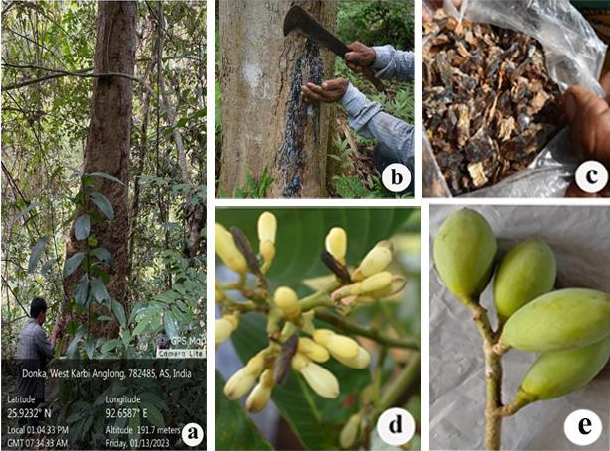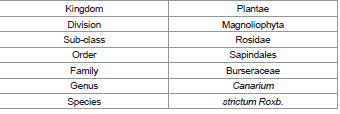Review Article
Ethno Botanical Significance of Critically Endangered Species, Canarium strictum Roxb :A Review
Terangpi K and Chanu LM*
Department of Botany, Assam Don Bosco University, Tapesia Gardens, Sonapur Assam, India
*Corresponding author: Longjam Malemganbee Chanu, Department of Botany, Assam Don Bosco University, Tapesia Gardens, Sonapur, Assam, India. Email id: longjam.chanu@adbuniversity.ac.in
Copyright: © Terangpi K, et al. 2023. This is an open-access article distributed under the Creative Commons Attribution License, which permits unrestricted use, distribution, and reproduction in any medium, provided the original work is properly cited.
Article Information: Submission: 02/09/2023; Accepted: 27/09/2023; Published: 03/10/2023
Abstract
For many decades, medicinal plants have been playing a significant role in the preparation of traditional medicines by different indigenous communities in and around the world as a form of primary healthcare. Canarium strictum Roxb. commonly known as black dammar or Yunnan tree is a large deciduous
tree used generally for the extraction of aromatic resin. This extreme extraction leads to the exploitation and decline of the species in their natural habitats and increases commercial value in the market. Canarium strictum Roxb. is well known for its therapeutic properties and hence abundantly used in the preparation of traditional medicines from different parts of the plant viz. bark, stem, leaf, fruit and resin. Several studies have also shown the presence of anti-bacterial, anti-microbial, anti-oxidant and anti-inflammatory properties in the resin, hence further research could help in the discovery of new drugs having lesser side effects in treating different ailments of humankind.
Keywords: Burseraceae; Canarium; Endangered; Ethno botany
Introduction
Since time immemorial, plants have become the source of food,
shelter, clothing, medicines and other livelihood purposes. Globally,
66 – 85% of world populations are dependent on 35,000 – 70,000
medicinal plants, out of which 6,500 were abundantly found in Asian
countries [1,2]. Harsberger explored the plants used by the aboriginals
and coined the term ethno botany for the first time in 1895. Presently,
it has become a distinctive branch in the field of natural science
interrelating with other disciplines such as anthropology, botany,
and ecology [3]. The field of ethno botany led to the discovery of
conventional medicines such as aspirin and reserpine which were
originally derived from Salix sp. and Rauwolfia sp. respectively [4].
New practices in pharmacological research have also been initiated
with the knowledge of medicinal plants used traditionally by ethnic
communities [1,5,6].
Canarium strictum Roxb. one of the critically endangered
species belonging to Burseraceae family, commonly known as black
dammar or Yunnan tree is widely used for the extraction of aromatic
resin [Figure 1]. The species is a poly-gamodiocious tree and widely
distributed in different parts of India, Myanmar and Yunnan province
located in China. Canarium strictum are mostly thriving in moist
deciduous to evergreen forests at an elevation ranging from ca. 750
– 1400 m [7]. In India, Canarium strictum is found distributing
naturally in Sikkim, Arunachal Pradesh, Assam, Meghalaya, Orissa,
Maharashtra, Karnataka, Kerala, Tamil Nadu and Andaman Islands
[8]. The resin of the Canarium strictum possesses several therapeutic
properties and is used for treating rheumatism, fever, cough, asthma,
epilepsy, hernia, and various bronchial ailments [7]. The powders of
resins are used for performing many religious rituals in India. They
are also used as excellent mosquito repellant [9-11]. The taxonomic
position of the Canarium strictum is given in [Table 1].
Figure 1: (a) Habit of Canarium strictum Roxb.; (b) Collection of resins; (c)
Dried and hardened resins; (d) Inflorescence; (e) Infructescence
Different Purposes of Canarium strictum Roxb:
Role in traditional medicinesThe decoction and infusion prepared from the bark of Canarium
strictum are used for the treatment of skin eruption and various colic
ailments. A mixture of Sesamum indicum oil and resin gum is also
used for reducing rheumatic pains [12]. The gum is also reported to
be utilized as an analgesic by the villagers residing in Thrissur and
Palakkad forest tract in Western Ghats [13]. The Kanikkars are tribal
inhabitants residing in some of the regions of the Tirunelveli district
in Tamil Nadu, India. They utilize the resin of Canarium strictum
for easing headaches and relieving common cold through smoke
inhalation [14]. The bark of Canarium strictum is used for treating
skin rashes by some of the local people residing in Mizoram [15]. The
dammar oil extracted from the Canarium strictum is applied over the
skin to treat rheumatism, asthma and venereal diseases. Powdered
resin is used for treating small or minor wounds and cuts by applying
it directly. The resin is also used for treating various skin diseases
such as psoriasis and pityriasis [16]. In Arunachal Pradesh, the local
people treat the itchiness and redness caused by poisonous hairs of
the caterpillar larvae by applying the fresh resin of Canarium strictum
over the affected areas [17]. Canarium strictum is considered one of
the important medicinal plants in Manipur as the resin of the plant
was used in the preparation of multi-ingredient herbal medicine for
treating polychondritis [18]. Local people residing in and around
Nongkhyllem Wildlife Sanctuary in Meghalaya and Arunachal
Pradesh were found consuming mature fruit of Canarium strictum
for curing indigestion and urinary problems [19,20]. The dried fruits
of Canarium strictum are chopped into small pieces and consumed
by some of the local inhabitants in Meghalaya and Nagaland to treat
nausea and motion sickness [21].
Religious and cultural aspects:
The aromatic resin of Canarium strictum is widely used for
fumigation and as incense in various religious ceremonies among
individual households and community gatherings [11]. The Kurichya
tribes of Wayanad district in Kerala utilizes the hardened resin in
many of their religious ceremonies such as fumigating the bow and
arrow before the hunting of Thulappathu or in the paddy fields during
Ayilyam-Makam, a festival which is held after Onam [22]. Local
people living in Singhason Hills of Karbi Anglong district, Assam use
resin to prevent the evil spirits and bad energies in their houses [10].
The Konyaks tribe of Mon district in Nagaland combines the soot
obtained from the exudates of Canarium strictum known as ying with
the leaf juice of the plant forming a dark green pigment which is then
utilized for tattooing [23].Other Miscellaneous Uses:
In different parts of India, the resins of Canarium strictum are
mainly used as a mosquito repellant while Irula tribes of Walayar
Valley in Kerala use bark instead of the resin. They also used the
powdered bark after mixing with Allium sativum and Curcuma longa
to apply on the skin directly to prevent mosquito bites [7,9,10,24].
Apart from repelling mosquitoes, the resins are also considered
an excellent replacement for burgundy pitch and used in medical
plasters. The timber obtained from mature Canarium strictum also
has tanguile properties and has been used in several ways for making
ceiling boards, flooring, room partitions, packaging cases, etc [7].
The ripe fruits of Canarium strictum are commonly found to be sold
in the local markets and used as wild edible fruit by the Adi tribes
of Arunachal Pradesh and Konyak tribes of Nagaland [25,26]. The
crushed leaves and crude extract of Canarium strictum are also used
in fish poisoning [12,27].Phytochemical Studies and Chemical Components:
Several phytochemical studies have shown the presence of
triterpenoids and terpenoids along with several compounds
such as α-amyrin, β-amyrin acetate, junenol, canarone, junenol,
canarone, epikhusinol and sesquiterpene ketone-canarone having
anti-microbial and anti-fungal properties in the resin of Canarium
strictum [15,28,29]. The presence of phenolic and alkaloids in fewer
amounts and the absence of flavonoids, steroids and anthraquinones
have also been shown in several phytochemical screening. The resin
of Canarium strictum shows anti-microbial activity against the microorganisms
Staphylococcus aureus and Pseudomonas aeruginosa [30].
The methanolic leaf extract of Canarium strictum is reported to be
effective against two vectors Culex quinquefasciatus and Aedes aegypti
at the LC₅₀ with a value of 263.0 ppm and 245.47 ppm respectively
[31].Research works:
The rate of germination in Canarium strictum is varied in different
habitats as well as in different chemical treatments. Seed treated with
10% concentrated H₂SO₄ and 10% concentrated HCl before sowing
shows a high rate of germination compared to natural growing [32].
The earliest germination of Canarium strictum is found in indolebutyric
acid (IBA) treatment at 2000 ppm and gibberellic acid (GA)
treatment at 1000 ppm while control treatment and mechanical
scarification leads to the lowest germination rate [8]. Soaking
the seeds in 4% H₂O₂ both in the nursery and laboratory shows
maximum germination percentage, germination value and peak value
compare to natural growing [33]. Exposing the seeds of Canarium
strictum to the radiation of gamma rays at 0 Gy – 200 Gy for a few
minutes increases the rate and speed of their germination [34]. Osmopriming
of seeds either with potassium dihydrogen phosphate or
GA₃ treatment breaks the dormancy of the seeds by 69.3% and 56%
respectively and enhances the rate of germination [35].Conclusion
With the survey of several literatures, it could be state that the
plant species, Canarium strictum has immense significance in various
aspects of human life viz. in traditional medicines, religious and
cultural aspects, and the presence of several vital phytochemical
compounds, an excellent mosquito repellant and as wild edible fruits.
The individual population of the plant is declining in their natural
habitats due to over-exploitation by humankind for their needs
and for its resin extraction. So far no proper conservation has been
initiated of this plant species in any part of the country. The species is
declining gradually and has become a critically endangered species.
The study recommends for urgent conservation of the plant properly
by regeneration of their vegetative parts or by propagating using in
vitro methods.
Acknowledgements
The authors are grateful to the tribal informants and traditional
practitioners for their kind hospitality and cooperation while sharing
their valuable knowledge and providing information.


